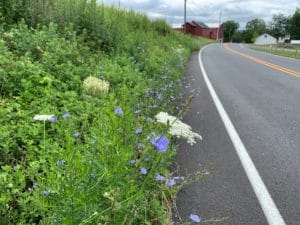Hello fellow readers, Last week, Queen Anne created quite a buzz. This week we have the “wild” Bachelor to talk about; Bachelor Buttons (Centaurea cyanus), also known as cornflowers. They’re an old-fashioned flower that has beautified gardens for centuries, first in Europe just as Queen Anne’s Lace (Daucus carota.) They grow well in full sun and are easy keepers.
 Bachelor Button Folklore
Bachelor Button Folklore
In folklore, young men in love wore cornflowers. If the flower faded too quickly, it was a sign that the man’s love was not received by his intended.
Just like the reality show, there’s a new bachelor every year. Bachelor Buttons are an annual plant rather than a perennial, which comes back year after year. He self-seeds vigorously (figures) and grows 16 to 35 inches tall with grey-green branches. The flowers are about an inch and a half and intense blue. In the past, he often self-seeded in crop fields, hence the name cornflower. So is he a weed or wildflower? The same question we asked of Queen Anne’s Lace.
Bachelor Buttons – endangered or invasive?
In Europe, he’s now endangered by agricultural intensification, primarily due to the overuse of herbicide destroying his native habitat. Plantlife’s conservation organization named him one of 101 species to bring ‘back from the brink.’ On the other hand, through the introduction as an ornamental plant in gardens and a seed contaminant in crop seeds, Bachelor Buttons have naturalized in many parts of the world. He’s now found wild in every state except Alaska and is considered weedy or invasive by some authorities.
Bachelor Buttons attract beneficial insects.
Rodale’s Organic Life published an article, ‘Flowers For Borders,’ that talks about controlling pests by planting the ’11 best flowers for borders’ that will draw beneficial insects into your garden. Guess what; the Bachelor was the first on their list to attract ladybugs, lacewings, ground beetles, and other insects that feed on pests. As a bonus, many beneficial bugs will also pollinate crops, thereby increasing yields. The article explains that Bachelor Buttons have extrafloral nectaries, which means their leaves release nectar even when the flowers are not in bloom – a plant ‘cologne’ of sorts.

 So what about all the buzz of Queen Anne hooking up with the Bachelor? I’m sure you’ve seen them often commingling alongside the road. You wild thing!
So what about all the buzz of Queen Anne hooking up with the Bachelor? I’m sure you’ve seen them often commingling alongside the road. You wild thing!
Garden Dilemmas? askmarystone@gmail.com
Click through to the previous column on Queen Anne’s Lace Anomaly.
This story is featured in Episode 18 of the Garden Dilemmas Podcast:
Column updated 6/17/22


